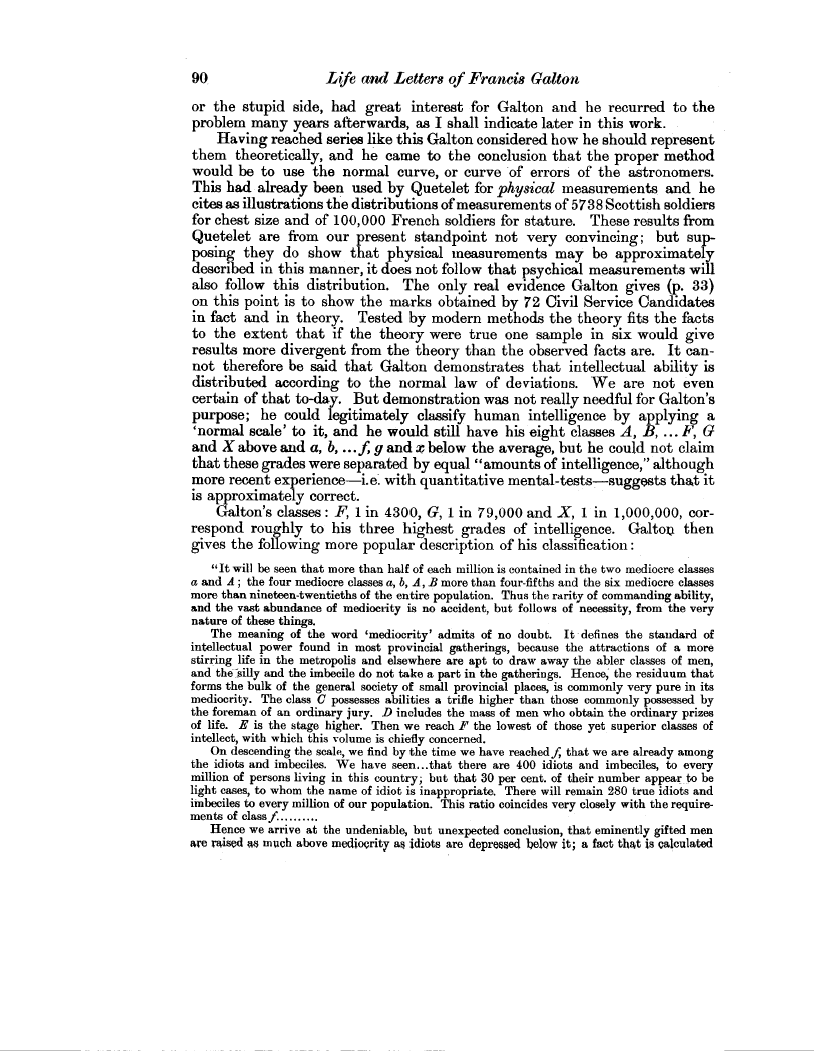90 Life and Letters of Francis Galton
or the stupid side, had great interest for Galton and he recurred to the problem many years afterwards, as I shall indicate later in this work.
Having reached series like this Galton considered how he should represent them theoretically, and he came to the conclusion that the proper method would be to use the normal curve, or curve of errors of the astronomers. This had already been used by Quetelet for physical measurements and he cites as illustrations the distributions of measurements of 5738 Scottish soldiers for chest size and of 100,000 French soldiers for stature. These results from Quetelet are from our present standpoint not very convincing; but supposing they do show that physical measurements may be approximately described in this manner, it does not follow that psychical measurements will also follow this distribution. The only real evidence Galton gives (p. 33) on this point is to show the marks obtained by 72 Civil Service Candidates in fact and in theory. Tested by modern methods the theory fits the facts to the extent that if the theory were true one sample in six would give results more divergent from the theory than the observed facts are. It cannot therefore be said that Galton demonstrates that intellectual ability is distributed according to the normal law of deviations. We are not even certain of that to-day. But demonstration was not really needful for Galton's purpose; he could legitimately classify human intelligence by applying a `normal scale' to it, and he would still have his eight classes A, B, ... F, G and X above and a, b, ... f, g and x below the average, but he could not claim that these grades were separated by equal "amounts of intelligence," although more recent experience-i. e: with quantitative mental-tests-suggests that it is approximately correct.
Galton's classes : F, 1 in 4300, G, 1 in 79,000 and X, 1 in 1,000,000, correspond roughly to his three highest grades of intelligence. Galton then gives the following more popular description of his classification
"It will be seen that more than half of each million is contained in the two mediocre classes a and d ; the four mediocre classes a, b, A, B more than four-fifths and the six mediocre classes more than nineteen-twentieths of the entire population. Thus the rarity of commanding ability,
and the vast abundance of mediocrity is no accident, but follows of necessity, from the very nature of these things.
The meaning of the word mediocrity' admits of no doubt. It defines the standard of intellectual power found in most provincial gatherings, because the attractions of a more stirring life in the metropolis and elsewhere are apt to draw away the abler classes of men, and the-silly and the imbecile do not take a part in the gatherings. Hence, the residuum that forms the bulk of the general society of small provincial places, is commonly very pure in its mediocrity. The class C possesses abilities a trifle higher than those commonly possessed by the foreman of an ordinary jury. D includes the mass of men who obtain the ordinary prizes of life. E is the stage higher. Then we reach F the lowest of those yet superior classes of intellect, with which this volume is chiefly concerned.
On descending the scale, we find by the time we have reached f, that we are already among the idiots and imbeciles. We have seen ... that there are 400 idiots and imbeciles, to every million of persons living in this country; but that 30 per cent. of their number appear to be light cases, to whom the name of idiot is inappropriate. There will remain 280 true idiots and imbeciles to every million of our population. This ratio coincides very closely with the requirements of class f
Hence we arrive at the undeniable, but unexpected conclusion, that eminently gifted men are raised as much above mediocrity as idiots are depressed below it; a fact that is calculated

